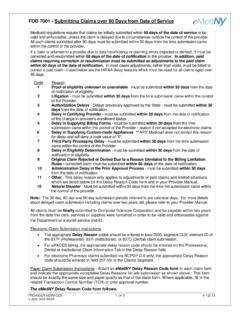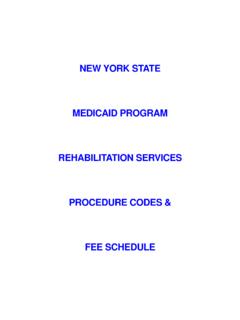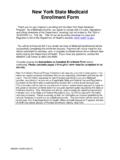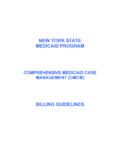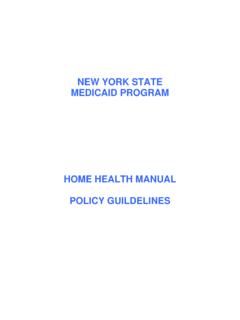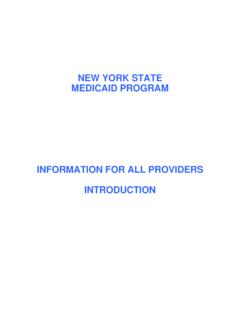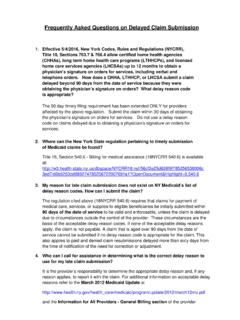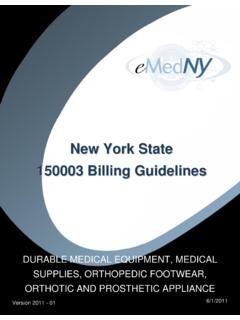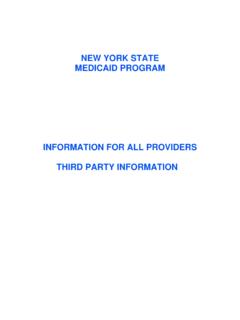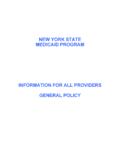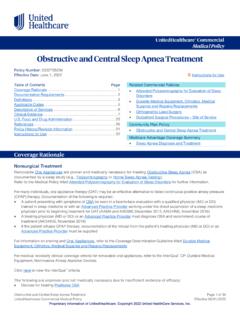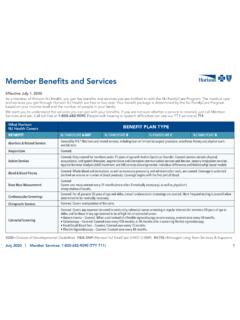Transcription of NEW YORK STATE MEDICAID PROGRAM PHYSICIAN – …
1 NEW YORK STATE MEDICAID PROGRAM PHYSICIAN PROCEDURE CODES SECTION 2 MEDICINE, DRUGS and DRUG ADMINISTRATION PHYSICIAN Procedure Codes, Section 2- Medicine, Drugs and Drug Administration Version 2019 Page 2 of 101 Table of Contents GENERAL RULES AND INFORMATION .. 3 MMIS MODIFIERS .. 13 EVALUATION AND MANAGEMENT services .. 15 LABORATORY services PERFORMED IN A PHYSICIAN 'S OFFICE .. 38 DRUGS AND DRUG ADMINISTRATION .. 39 IMMUNIZATIONS .. 39 DRUGS ADMINISTERED OTHER THAN ORAL METHOD .. 43 HYDRATION, THERAPEUTIC, PROPHYLACTIC AND DIAGNOSTIC .. 53 CHEMOTHERAPY DRUGS .. 57 MEDICINE.. 61 PSYCHIATRY .. 61 DIALYSIS .. 64 GASTROENTEROLOGY ..67 OPHTHALMOLOGY .. 68 SPECIAL OTORHINOLARYNGOLOGIC services .. 73 CARDIOVASCULAR .. 76 NONINVASIVE VASCULAR DIAGNOSTIC STUDIES .. 87 PULMONARY ..89 ALLERGY AND CLINICAL IMMUNOLOGY .. 90 NEUROLOGY AND NEUROMUSCULAR PROCEDURES .. 92 CENTRAL NERVOUS SYSTEM ASSESSMENTS/TESTS.
2 97 PHOTODYNAMIC THERAPY .. 98 SPECIAL DERMATOLOGICAL PROCEDURES .. 98 OSTEOPATHIC MANIPULATIVE TREATMENT.. 99 SPECIAL services ..99 MODERATE (CONSCIOUS) SEDATION .. 100 OTHER services AND PROCEDURES .. 100 PHYSICIAN Procedure Codes, Section 2- Medicine, Drugs and Drug Administration Version 2019 Page 3 of 101 GENERAL RULES AND INFORMATION 1. PRIMARY CARE: Primary care is first contact care, the type furnished to individuals when they enter the health care system. Primary care is comprehensive in that it deals with a wide range of health problems, diagnosis and modes of treatment. Primary care is continuous in that an ongoing relationship is established with the primary care practitioner who monitors and provides the necessary follow-up care and is coordinated by linking patients with more varied specialized services when needed. Consultations and care provided on referral from another practitioner is not considered primary care.
3 2. CLASSIFICATION OF EVALUATION AND MANAGEMENT (E/M) services : The Federal Health Care Finance Administration has mandated that all STATE MEDICAID programs utilize the new Evaluation and Management coding as published in the American Medical Association's Physicians' Current Procedural Terminology. For the first time, a major section has been devoted entirely to E/M services . The new codes are more than a clarification of the old definitions; they represent a new way of classifying the work of practitioners. In particular, they involve far more clinical detail than the old visit codes. For this reason, it is important to treat the new codes as a new system and not make a one-for-one substitution of a new code number for a code number previously used to report a level of service defined as "brief", "limited", "intermediate", etc. The E/M section is divided into broad categories such as office visits, hospital visits and consultations.
4 Most of the categories are further divided into two or more subcategories of E/M services . For example, there are two subcategories of office visits (new patient and established patient) and there are two subcategories of hospital visits (initial and subsequent). The subcategories of E/M services are further classified into levels of E/M services that are identified by specific codes. This classification is important because the nature of practitioner work varies by type of service, place of service, and the patient's status. The basic format of the levels of E/M services is the same for most categories. First, a unique code number is listed. Second, the place and/or type of service is specified, eg, office consultation. Third, the content of the service is defined, eg, comprehensive history and comprehensive examination. (See levels of E/M services following for details on the content of E/M services .) Fourth, the nature of the presenting problem(s) usually associated with a given level is described.
5 Fifth, the time typically required to provide the service is specified. 3. DEFINITIONS OF COMMONLY USED E/M TERMS: Certain key words and phrases are used throughout the E/M section. The following definitions are intended to reduce the potential for differing interpretations and to increase the consistency of reporting. NEW AND ESTABLISHED PATIENT: Solely for the purpose of distinguishing between new and established patients, professional services are those face-to-face services rendered by a PHYSICIAN and reported by a specific code. A new patient is one who has not received any professional services from the practitioner or practitioners working in the same specialty within the same group within the past three years. An established patient is one who has received professional services from the practitioner within the past three years. PHYSICIAN Procedure Codes, Section 2- Medicine, Drugs and Drug Administration Version 2019 Page 4 of 101 In the instance where a practitioner is on call for or covering for another practitioner, the patient's encounter will be classified as it would have been by the practitioner who is not available.
6 No distinction is made between new and established patients in the emergency department. E/M services in the emergency department category may be reported for any new or established patient who presents for treatment in the emergency department. CHIEF COMPLAINT: A concise statement describing the symptom, problem, condition, diagnosis or other factor that is the reason for the encounter, usually stated in the patient's words. CONCURRENT CARE: is the provision of similar services , eg, hospital visits, to the same patient by more than one practitioner on the same day. When concurrent care is provided, no special reporting is required. Modifier -75 has been deleted. COUNSELING: Counseling is a discussion with a patient and/or family concerning one or more of the following areas: diagnostic results, impressions, and/or recommended diagnostic studies; prognosis; risks and benefits of management (treatment) options; instructions for management (treatment) and/or follow-up; importance of compliance with chosen management (treatment)options; risk factor reduction; and patient and family education.
7 FAMILY HISTORY: A review of medical events in the patient s family that includes significant information about: the health status or cause of death of parents, siblings, and children; specific diseases related to problems identified in the Chief Complaint or History of the Present Illness, and/or System Review; diseases of family members which may be hereditary or place the patient at risk. HISTORY OF PRESENT ILLNESS: A chronological description of the development of the patient s present illness from the first sign and/or symptom to the present. This includes a description of location, quality, severity, timing, context, modifying factors and associated signs and symptoms significantly related to the presenting problem(s). NATURE OF PRESENTING PROBLEM: A presenting problem is a disease, condition, illness, injury, symptom, sign, finding, complaint, or other reason for encounter, with or without a diagnosis being established at the time of the encounter.
8 The E/M codes recognize five types of presenting problems that are defined as follows: Minimal A problem that may not require the presence of the practitioner, but service is provided under the practitioner s supervision. Self-limited or Minor A problem that runs a definite and prescribed course, is transient in nature and is not likely to permanently alter health status OR has a good prognosis with management/compliance. Low severity A problem where the risk of morbidity without treatment is low; there is little to no risk of mortality without treatment; full recovery without functional impairment is expected. Moderate severity A problem where the risk of morbidity without treatment is moderate; there is moderate risk of mortality without treatment; uncertain prognosis OR increased probability of prolonged functional impairment. PHYSICIAN Procedure Codes, Section 2- Medicine, Drugs and Drug Administration Version 2019 Page 5 of 101 High severity A problem where the risk of morbidity without treatment is high to extreme; there is a moderate to high risk of mortality without treatment OR high probability of severe, prolonged functional impairment.
9 PAST HISTORY: A review of the patient s past experiences with illnesses, injuries, and treatments that includes significant information about: prior major illnesses and injuries; prior operations; prior hospitalizations; current medications; allergies ( , drug, food); age appropriate immunization status; age appropriate feeding/dietary status. SOCIAL HISTORY: an age appropriate review of past and current activities that include significant information about: marital status and/or living arrangements; current employment; occupational history; use of drugs, alcohol, and tobacco; level of education; sexual history; other relevant social factors. SYSTEM REVIEW (REVIEW OF SYSTEMS): An inventory of body systems obtained through a series of questions seeking to identify signs and/or symptoms which the patient may be experiencing or has experienced. The following elements of a system review have been identified: Constitutional symptoms (fever, weight loss, etc.)
10 Eyes Ears, Nose, Mouth, Throat Cardiovascular Respiratory Gastrointestinal Genitourinary Musculoskeletal Integumentary (skin and/or breast) Neurological Psychiatric Endocrine Hematologic/Lymphatic Allergic/Immunologic The review of systems helps define the problem, clarify the differential diagnoses, identify needed testing, or serves as baseline data on other systems that might be affected by any possible management options. PHYSICIAN Procedure Codes, Section 2- Medicine, Drugs and Drug Administration Version 2019 Page 6 of 101 TIME: The inclusion of time in the definitions of levels of E/M services has been implicit in prior editions. The inclusion of time as an explicit factor beginning in 1992 is done to assist practitioners in selecting the most appropriate level of E/M services . It should be recognized that the specific times expressed in the visit code descriptors are averages, and therefore represent a range of times which may be higher or lower depending on actual clinical circumstances.
